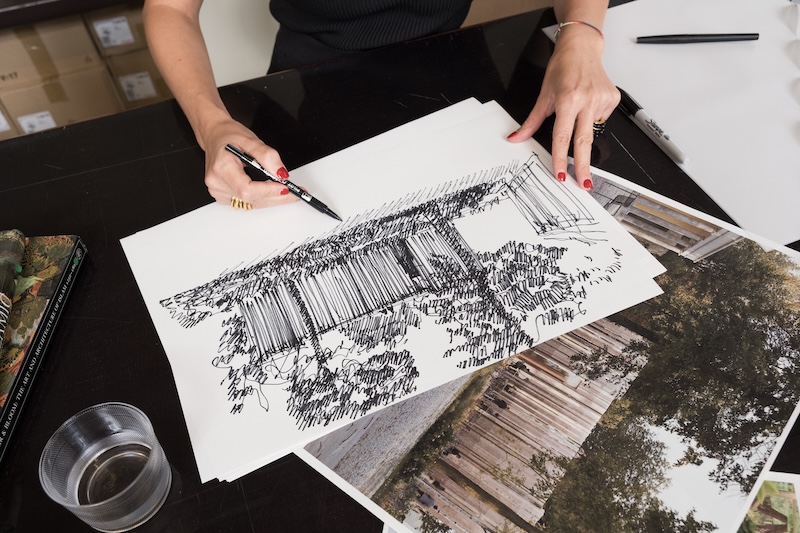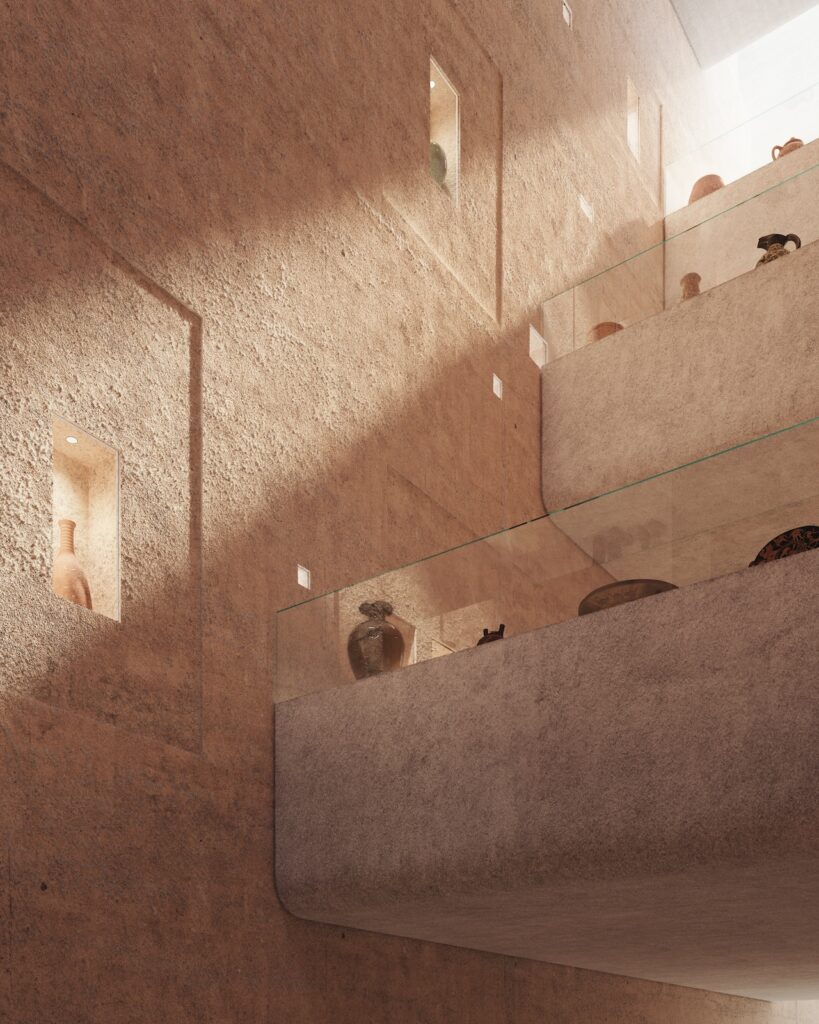
Qatar Museums has commissioned Lebanese architect Lina Ghotmeh to design a permanent national pavilion for the Venice Biennale – the first to be added to the Giardini in 30 years
Photography Brigitte Lacombe
At the heart of each exhibition is the Giardini, a landscaped park in the east of the city that houses 29 national pavilions plus the large Central Pavilion, each one a permanent architectural marker of a country’s presence. At the opening of the 2025 festival in May – it closes on 23 November – the organisers announced a new addition to the Giardini in the form of the Qatar Pavilion, to be designed by Paris-based Lebanese architect Lina Ghotmeh. It is one of only three new additions to the Giardini in the past half-century and the first by a female architect. The much-anticipated project marks a significant milestone not only for Qatar, but also for the broader representation of the Arab world in one of the most symbolically loaded sites in contemporary architecture.
“It’s a very important moment,” says Ghotmeh, founder of Lina Ghotmeh Architecture (LGA). “It’s about bringing a voice for Qatar and the Arab world into the Giardini, a place where art, architecture and different forms of creativity are present at every biennale. It’s so important that there is diversity and representation here.”
When Ghotmeh was announced as the architect of the Qatari Pavillion in Venice. Sheikha al-Mayassa said in a statement “[Ghotmeh’s] work is inspiring new and traditional audiences with its sensitivity to the human condition and confident innovative flair”
“Growing up in a war-torn city… there is a desire to heal, rebuild and to bring beauty back into the environment”
Lina Ghotmeh
Ghotmeh brings to the project a deeply personal understanding of memory, place and cultural expression. Born and raised in Beirut, she lived through the city’s destructive conflicts and reconstruction, an experience that inspired her early interest in the built environment and that continues to shape her architectural approach today. “Growing up in a war-torn city – where you constantly see buildings being demolished – there is a desire to heal, rebuild and to bring beauty back into the environment,” she explains. “Living through moments of conflict also made me consider the role architecture plays in bringing people together. It’s a way to rebuild the connection between people and our surroundings.”
Beirut has a history that stretches back more than 5,000 years, and this rich past is another reference in Ghotmeh’s work. Inspired by these layers of history – evident in the city’s many archaeological sites – much of her work is an exploration of what defines a site in social, historical and material terms, and how this can be expressed in a way that feels relevant today.
This thinking followed her to Paris, where she relocated after being invited to work on a project in Beirut by renowned French architect Jean Nouvel. Soon after this move Ghotmeh participated in and won an architectural competition for the design of the Estonian National Museum, which prompted her to set up her own studio. “Fate and destiny brought me to Paris,” she says. “It’s a context that allows you to see things differently, to look at your own heritage with a new perspective. There’s a sensitivity to history, to heritage and to beauty that’s very present in France. It is very different to how beauty might be approached in Lebanon.”
While Ghotmeh is reluctant to define contemporary Arab style – “We’re still in a moment where questions of identity are being asked and rebuilt” – the strong throughlines in the region’s architectural heritage do inform her practice. She refers to the work of noted Egyptian architect Hassan Fathy (1900-89), who championed the use of vernacular construction methods, and she speaks passionately about the ways in which traditional Arab architecture can offer solutions to contemporary concerns about climate, ecology and resources.
Perhaps most notable, however, is the way Ghotmeh encourages togetherness in the spaces she creates. “I believe architecture should offer spaces of hospitality that embrace people,” she says. “That’s something that is very present in Arab architecture.” It is this sense of welcoming hospitality that underpins her design for the Qatar Pavilion.
The commission came as a result of a six-month competition launched by Qatar Museums under the stewardship of Her Excellency Sheikha al-Mayassa Al Thani. Ghotmeh was one of more than a dozen architects invited to partake in workshops and site visits. The jury, chaired by Dutch architect Rem Koolhaas, selected her winning proposal for its conceptual clarity and sense of cultural rootedness – hallmarks of Ghotmeh’s practice.
At the time of writing, construction on the pavilion is yet to begin and the site – which is adjacent to the James Stirling-designed Book Pavilion at the centre of the Giardini – is currently occupied by an installation by Pakistani architect Yasmeen Lari. Titled Community Centre, the structure represents Qatar’s first official involvement in the architecture biennale and is part of a larger programme titled Beyti Beytak. My home is your home. La mia casa è la tua casa, which was produced by Qatar Museums. The domed structure by Lari is constructed entirely of bamboo and explores how craft, community and hospitality are integral to the architecture of the Middle East, North Africa and South Asia regions.
This temporary installation poetically foreshadows themes Ghotmeh has focused on for the Qatar Pavilion. “The challenge was how to create a pavilion that expresses Qatar without falling into cliché or a reductive identity,” she says. “It needs to express something deeply rooted in Qatari culture, but also reference the meeting point between Qatar and Venice.”
Ghotmeh began by exploring Qatari culture in depth, looking at the value placed on handicrafts and hospitality, as well as the tradition of pearl-diving, which is deeply ingrained in the country’s national identity. In parallel, she looked at the history of Venice, the identity of which has always been defined by water, and started to draw connections between the two places.
“The facade has a sense of verticality, of rhythm – it’s almost as if the whole building is a waterfall,” she says of her design. “There’s a sense of the built form rising up but also flowing down. This rhythm also echoes some of the stonework you see in Venice.” Local materials that hint at artisanal traditions of both Qatar and Venice – weaving, glasswork and stone – are celebrated.
Inside, a large hall will accommodate exhibitions, and a publicly accessible rooftop will offer previously unseen views across the Giardini. As a result, the pavilion not only invites the public to explore Qatari culture, but is conceived as a collaborative platform to bring together artists, curators and other creatives from Qatar and the region. “I want people to feel welcomed into an environment that transports them into another way of seeing the world,” says Ghotmeh. “They should come away having had a meaningful experience, and feel a sense of hospitality and place.”
The first render of Ghotmeh’s design for the permanent Qatar Pavilion in the Giardini della Biennale in Venice, revealed at the Venice Architecture Biennale in May 2025. Photo: © Lina Ghotmeh Architecture. 2025-current
The sensitivity to context that the Qatar Pavilion so beautifully captures runs through all of Ghotmeh’s work. “Every place has its own dynamic, its own resources, its own history,” she says. At the British Museum in London, for example, where Ghotmeh has been selected to renovate the Western Range galleries, she has proposed lofty, light-filled spaces punctuated by clerestory windows and arched openings. The galleries house objects from the Middle East, Syria and Egypt collections, and the renovated space will encourage visitors to explore the relationships between the objects and their current context. “It’s about how architecture can play a role in helping people gain a deeper understanding of that history,” she says. “We also wanted to bring breathing space back into the museum and restore the sense of the extraordinary that museums have the potential to offer.”
In Seoul, South Korea, LGA is working on a library and in Toyama, Japan, it is designing an observatory, both designed to foster public engagement. In Normandy, France, Ghotmeh’s practice has recently completed a low-carbon, energy-positive atelier for luxury brand Hermès. “That project was about the work of the hand,” she explains. “About using earth from the site, building sustainably and valuing craftsmanship.”

“I think the world urgently needs beauty – moments that bring us together and build peace”
Lina Ghotmeh
Most recently, in September, it was announced that she is to design the Jadids’ Legacy Museum in Bukhara, Uzbekistan. Designed to tell the story of the Jadid movement – a reformist group in the late 19th and early 20th century that operated across Central Asia – the museum is a conversion of a 19th-century house that was once home to the first president of the Bukharan People’s Republic.
Each LGA project takes a different form, but they are all rooted in the same careful attention to place, material and meaning that defines the upcoming Qatar Pavilion. For Ghotmeh, it is clear that the power of architecture lies in its ability to act as a bridge between cultures, and the way it can preserve memory, while opening space for future possibilities.
“What excites me most about being an architect is working across different cultures, and the capacity of architecture to link people and bring beauty,” she says. “I think the world urgently needs beauty – moments that bring us together and build peace.”
We use cookies to improve your experience on our site. By using our site, you consent to cookies.
Manage your cookie preferences below:
Essential cookies enable basic functions and are necessary for the proper function of the website.
These cookies are needed for adding comments on this website.
Statistics cookies collect information anonymously. This information helps us understand how visitors use our website.
Google Analytics is a powerful tool that tracks and analyzes website traffic for informed marketing decisions.
Service URL: policies.google.com